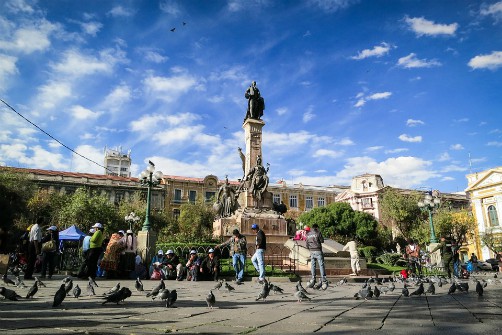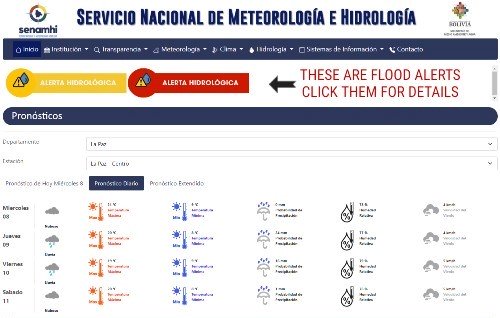|
The Weather in La Paz Bolivia The weather in La Paz Bolivia is cool to warm year-round but rarely gets extremely hot. It's also fairly arid, except during the rainy season. Because La Paz is built inside a deep, wide gorge shaped like a bowl, with it's city center at 3650 meters (11,975 feet) above sea level and it's Zona Sur (southern neighborhoods) at only 3300 meters (10,827 feet) above sea level, differences in temperature can be felt in various zones of the city.
High above downtown La Paz, at 4082 meters (13,392 feet) above sea level, is the city of El Alto where the La Paz International airport is located. Before 1987, when El Alto separated from La Paz and was incorporated as a city, La Paz was the second highest city in the world. Now El Alto is the second highest and La Paz is the third. The world's highest city is still Potosí, Bolivia at 4090 meters (13,419 feet) above sea level. Because the city is surrounded by mountains, the sun drops behind them fairly early in the evening and temperatures drop dramatically overnight. During the summer (November to April, also the rainy season) the average temperature is 72ºF (22ºC). During the winter (the dry season) temperatures drop to an average of 59ºF (15ºC). The widget below provides a 14-day La Paz Bolivia weather forecast.
 Weather in La Paz Bolivia: dry seasonThe dry season in Bolivia takes place between May and October (sometimes extending into November). As so many tourist attractions in Bolivia involve outdoor adventures like hiking, climbing, and rappelling (and often long drives on dirt roads to get the sites) the dry season is the safest time to visit as you’ll avoid rain delays or cancellations that may ruin your plans. You’ll also avoid some of the disasters that are common during the rainy season such as flooding and landslides. The best time to visit La Paz is probably near the beginning of the dry season (May and June) simply because it is not yet peak travel season and you won’t encounter as many other travelers at popular tourist destinations and sites. The downside is that these are also our colder months of the year with June and July usually being the coldest. Days are shorter as well. June 23rd is the shortest, and often the coldest, day of the year which is why Bolivians celebrate San Juan that night with bonfires and hot drinks, much music, alcohol and merriment. The longest days of the year are in November, just prior to the onset of the warmer rainy season. Temperatures during the winter can fall below zero with highs barely in the 50’s (Fahrenheit) for an hour or two at midday. You should be prepared to pack plenty of warm clothing. Hostels and lower-priced hotels in La Paz and other highland areas often don’t have central heating. If you plan to travel long distances by bus, prepare by dressing warmly, in layers, wearing an extra pair of socks, and perhaps even investing in a wool blanket (which are inexpensive in Bolivia and you can give away before you travel home if you don’t have room in your luggage). Bolivian buses are sometimes cold and drafty, especially if you plan to visit the communities such as Oruro, Tiahuanaco, or Lake Titicaca, on the Altiplano, or if you travel at night. Weather in La Paz Bolivia: rainy seasonThe rainy season in Bolivia extends between November and April with January to March usually being the three wettest months. If you hope to enjoy a lot of outdoor activities (trekking, climbing, river rafting, etc.) it’s best to avoid the first 3 months of the year when the rains are heavy, rivers swell, and flooding and landslides make roads unpassable. For example, you wouldn't want to plan a trip down Death Road during the rainy season. Airports in smaller, more distant cities frequently close as well. In November and December (when the rainy season is just beginning) and April (usually the last wet month) it doesn’t rain quite as heavily and you may have sunny days with occasional showers. The upside is that the weather in La Paz Bolivia, while never very hot, is warmer and more pleasant during these months. This is possibly the best time to visit La Paz if you are not planning a lot of hardcore outdoor adventures. You’ll be able to shop at outdoor markets, walk the city, visit museums and galleries, and even enjoy some meals at outdoor restaurants. So which is the best season to travel to La Paz? That depends on you. How willing are you to be flexible or spontaneous? Which sites do you plan to see? Will most of your activities be indoors or outdoors? Let's recap: January, February and March are wet, wet, and wet. In April the rains subside. In May and June the weather in Bolivia begins to cool down and dry up, and days are short. July and August, the two coldest months of the year, are also the driest and the two months when Bolivia receives the most tourists. In September and October the days lengthen, you’ll see very little rain, and the weather begins to warm. November and December are warm to hot and the rainy season will once again begin. You can also visit the website of the Bolivian National Meteorology and Hydrology Service SENAMHI for real time local weather conditions and forecasts in dozens of Bolivian cities plus real time flood alerts.
Only you can decide when you prefer to visit. But if you do come in the cold, crisp winter and you’re sipping coca tea because you’re chilled to the bone wondering if you made the right decision, take a moment to remind yourself that you are standing two miles above the world, in one of the highest cities on Earth, under one of the bluest skies on the planet.  |

